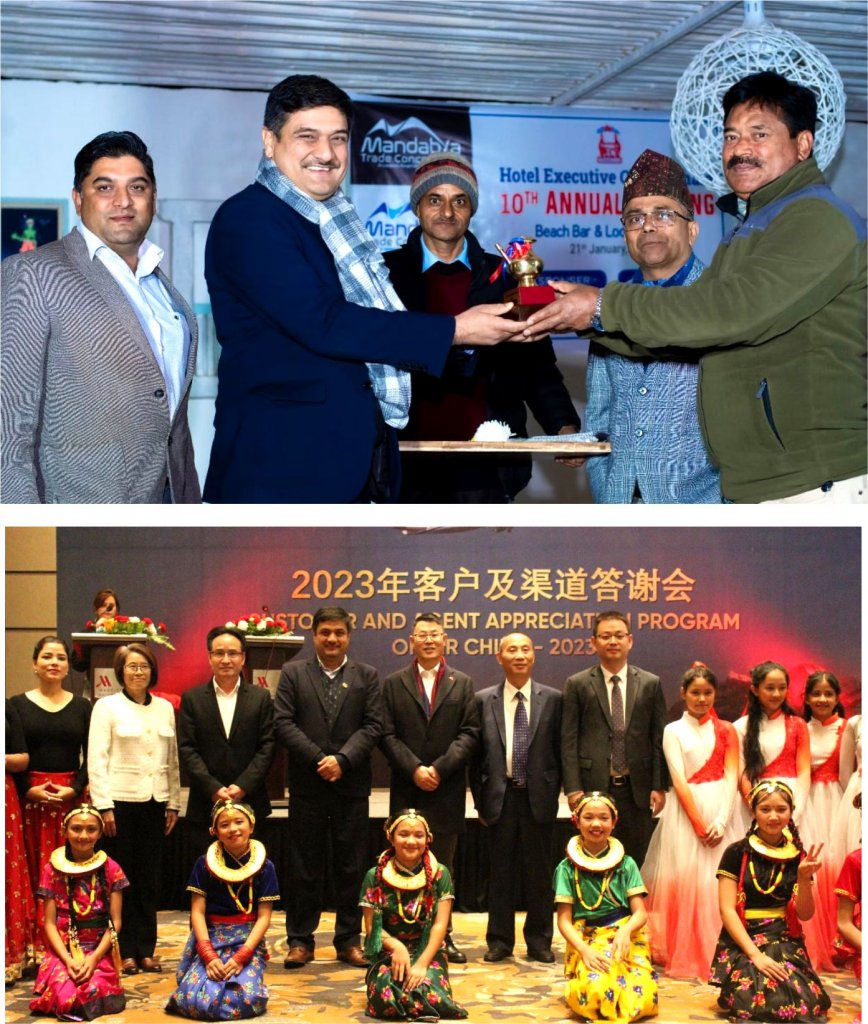TMS. Home to world’s highest mountain Mt. Everest, to the world’s deepest Gorge Kali Gandaki Gorge, could you tell us some other enthralling facts about Nepal, major attractions and what makes it a unique vacation destination?
Mani Raj Lamichhane. Nepal is a unique and breathtaking travel destination which offers many unique experiences for all types of visitors. From high Mountains to hills to Terai landscape, this tiny country spreads over from 60 m to 8,848.68 m having diverse landscapes, flora, fauna with rich bio diversity, offering many attributes to all kinds of visitors. The country Some of the major attractions of Nepal are:
10 UNESCO world heritage sites
Rara Lake: A lake situated at an altitude of 2,990m, is the biggest and deepest lake in Nepal
Tilicho Lake: A lake situated at an altitude of 4,919 meters also known as the highest lake for its size in the world
Shukla Phanta National Park located in Sudhurpachim Province (350 km from Delhi) is popularly known for the largest grassland of Nepal and is a home to the largest herds of Swamp Deer in the world.
Nepal protected areas that cover 23.39% of its total land area which is equivalent to 34,419 km2 and is leading sustainable tourism destination in South Asia
Altitudes range from 67 m (220 ft) in the south-eastern Terai to 8,848 m (29,029 ft) at Mount Everest within a short horizontal span.
Nepal has 10 national parks, 4 wildlife reserve, 1 hunting reserve and 6 conservation areas
All these destinations are unique and pristine, which has no alternative elsewhere. This makes this destinations a unique vacation destination.

TMS. The culture of Nepal encompasses the various cultures belonging to 125 distinct ethnic groups. Kindly highlight the statement and provide us with an in-depth understanding of the cultural diversity of Nepal.
Mani Raj Lamichhane. There are 142 castes/ethnicities (125 are the ones which were also reported in the earlier census 2011 and 17 are newly found and 124 mother tongues (111 are the ones which were also reported in the earlier census 2011 and 13 are newly found) according to the National population and housing census 2021.
Nepal is a country known for its rich cultural diversity. Situated in South Asia, between India and China, Nepal is home to a wide range of ethnic groups, each with its own distinct traditions, languages, customs, and practices. The cultural diversity of Nepal is influenced by its geography, history, and the mix of ethnic communities residing within its borders. Ethnic Groups: Nepal officially recognizes 142 ethnic groups, with the largest being the Indo-Aryan and Sino-Tibetan ethnic groups. Some of the major ethnic groups include the Chhetri, Brahmin, Newar, Magar, Tamang, Gurung, Tharu, Rai, Limbu, Sherpa, and Maithili. Each group has its own unique cultural practices, languages, attire, festivals, and religious beliefs.
Religion: Nepal is predominantly a Hindu-majority country, with Hinduism being the largest religion. However, Nepal is also home to significant populations of Buddhists, Muslims, Christians, and followers of indigenous religions like Bon and Kirat. The coexistence of multiple religions adds to the cultural tapestry of Nepal, and you can find numerous temples, monasteries, mosques, and churches throughout the country. Languages: Nepal is a linguistically diverse nation, with over 120 languages spoken. The official language is Nepali, which is widely spoken and understood across the country. However, each ethnic group has its own native language, many of which are still actively used in daily life. Newari, Maithili, Bhojpuri, Tamang, Gurung, and Magar are among the numerous languages spoken in different regions of Nepal.
Festivals and Celebrations: Nepal is known for its vibrant and colorful festivals, which are celebrated with great enthusiasm by people of all ethnicities. Dashain and Tihar (also known as Diwali) are the most important and widely celebrated Hindu festivals in Nepal. Other significant festivals include Holi (the festival of colors), Bisket Jatra, Teej, Chhath, Lhosar, Maghe Sankranti, and Gai Jatra. These festivals involve religious rituals, traditional dances, music, feasting, and social gatherings. Art and Architecture: Nepal has a rich artistic heritage, particularly in the field of architecture and craftsmanship. The Newar community, known for their intricate wood and stone carvings, has played a significant role in shaping the traditional.
Overall, Nepal’s cultural diversity is a testament to the country’s rich heritage and the harmonious coexistence of various ethnic groups and religions. This diversity is celebrated and cherished by the people, making Nepal a fascinating and culturally vibrant nation.
TMS. How has international synergy been like between India and Nepal in the last few years? How do you see India as a source market for the tourism in Nepal?
Mani Raj Lamichhane. Nepal and India share an age-old
friendly bilateral relation based on mutual cooperation, co-existence and having special connection from the geographical, historical, cultural, economic and religious perspectives. The two countries have put an extra effort to enhancing the bilateral economic cooperation and creating favorable environment for economic growth.
India remains a largest trading partner to Nepal and the largest source of foreign investments in the sectors particularly tourism, technology, infrastructure and hospitality to name a few. India is considered as vital and budding source market and taken with utmost importance and priority when it comes to Nepal’s tourism promotion and marketing. Given that the two countries share geographical proximity, religious, cultural and lingual commonality, the promotion of cultural and religious tourism will help to further solidify the people to people relationship between the two countries. The recent opening of Ram-Lalla temple in Ayodhya, and Lord Ram’s marriage with Goddess Sita in Janakpurdham, Nepal centuries back has further fortified and strengthened the cultural and religious connection between Nepal and India. India encircles Nepal in its three bordering directions, east, west and south sharing a long border specifically with four states West Bengal, Bihar, Uttar Pradesh and Uttarakhanda.
The population distribution of in these states are: West Bengal (9.13 crore), Bihar (10.38 crore), Uttar Pradesh (19.95 crore), and Uttarakhanda has (1.11 crore) as per the India’s population census data 2011 which also shows the great potentiality of tourism florishment in Nepal.
Additionally, air connectivity between major Indian cities and Kathmandu, Nepal’s capital, has improved, making it more convenient for Indian tourists to visit Nepal. Several Indian airlines operate regular flights to Nepal, further strengthening the travel links between the two countries. India’s role as a source market for Nepal’s tourism industry is expected to remain significant in the future. The close proximity, shared history, and cultural affinities between the two countries provide a natural advantage for attracting Indian tourists to Nepal. This shows that India is a major source market for the tourism in Nepal.
TMS. How is the Nepal Tourism Board involving local communities in tourism development?
Mani Raj Lamichhane. Local communities play pivotal role in overall tourism development in Nepal. Nepal Tourism Board (NTB) has been utilizing its resources, both human and capital, to identifying the local products, enabling local communities to manage resources, enhancing their entrepreneurship skills by keeping intact the authenticity of local culture and traditions. As a result of which the “Home Stay” has turned out to be the flagship tourism product of Nepal that provides incredible experiences through the authentic Nepali culture, traditions, local foods and cuisines which is unique in itself. Homestay is a unique model of tourism development at the local level.
The concept of Home Stay emerged with an objective of empowering the local communities via developing new tourism product from the available local resources. We’ve also started a joint initiative with UNDP and run a project named Sustainable Tourism for Livelihood Recovery (STLR) Project which engaged more than 10,000 local communities creating short term jobs, and development of the tourism infrastructures nearby.
TMS. Nepal is famous for its rich cultural diversity, natural beauty, and delicious delicacies. What are some mouthwatering culinary delicacies of Nepal?
Mani Raj Lamichhane. Nepali delicacies such as momos, sel roti, gundruk, indegineous pickle are overwhelmingly popular around the globe, showcasing Nepal’s rich cultural diversity. Talking of the delicacies, some of the Nepali cuisines gained worldwide popularity after they were showcased in BBC’s Master Chef TV show. The specialty of Nepali cuisines and delicacies is that they are prepared by Nepalese to celebrate different cultures and festivities as per the Nepali calendar. To me, “Thakali Thali” or “Thakali Palate” that includes rice, lentils, fermented pickle of radish, tomato spicy puree, vegetables, choice of goat meat, fish or chicken with a spoon of butter or ghee is considered as an authentic mouthwatering delicacy.
TMS. How does the Nepal tourism collaborate with the government and other stakeholders for mutual benefits? What role do partnerships play in the sustainable development of Nepal tourism?
Mani Raj Lamichhane. Following the federal set-up in Nepal, NTB has been collaborating with the local governments for the conduction of tourism fairs, travel marts and seminars, construction of tourism infrastructures at the local levels with an objective of making local government, stakeholders directly engaged in the development of local tourism products, promotion of local tourism products and its marketing in the international level. For holding international promotion events, NTB collaborates with the travel trade sectors, travel and tourism associations and development partners. Inarguably, the partnership with the tourism stakeholders and development partners play a very crucial role for the sustainable development of Nepal’s tourism sector.
With this profound realization and materialization of sustainability concept, I would like to share with that NTB in joint collaboration and partnership with United Nations Development Program(UNDP) has been operating sustainable tourism livelihood project in various places of Nepal.This project launched during the post COVID period has already achieved its goal of making the tourism entrepreneurs and workers adopt the sustainable means while conducting their tourism activities and businesses.
TMS. How does Nepal stand out in its ability to host MICE events, with a particular focus on highlighting the strengths of its MICE infrastructure?
Mani Raj Lamichhane. Talking of Nepal’s ability to host MICE events, I must say that the country has full potential of hosting MICE events particularly in Kathmandu, Pokhara, Chitwan, Lumbini and other parts of the country. The advantage of holding such events in Kathmandu is the city in itself is a natural heritage site and those participating the events can take a tour around the city, relax, enjoy and experience the normal life and ambience of the city. We have a good number of hotels in Kathmandu and they operate in full capacity during the holiday seasons. Similarly, if the organizers choose the beautiful city of Chitwan which is just about 60 miles away from Kathmandu as their MICE event destination then they will not only be offering an event outside the crowded city areas but also will provide a golden opportunity to the participants for getting the authentic experience of local people, their culture, traditions, food and cuisines, traditional dances, folk songs etc.
Chitwan is mostly popular to tourists for sightseeing of one horned rhino and experiencing jungle safari. Now, if we talk of Pokhara as MICE event destination, the place is popular among the tourists for its natural beauty, mountains, lakes, temples, hiking trails, authentic local cuisines and delicacies. This popular destination has beautiful and luxurious hotels that provide
top class hospitality to the tourists visiting Nepal. Talking of or wedding, anniversary and similar functions. Lumbini as an another potential destination, that’s the place where Lord Buddha was born many centuries back. The place carries historical, cultural, religious significance and most importantly it’s an abode of peace and tranquility. Thus, guests and participants attending MICE events can practice spiritualism, perform meditation and get the firsthand information on Buddhism. Recently, we have hosted Indo Nepal Wedding Summit in Kathmandu, which was attended by more than 40 top wedding planners from all over India to promote Nepal as the next door wedding destination, to attract the middle class and upper middle class f The massive 5 star properties coming up in popular destinations like Kathmandu, Pokhara and border town cities. The participants from India were highly impressed by the properties and as a result two weddings have already been done by some of the planners.
Thus, guests and participants attending MICE events can practice spiritualism, perform meditation and get the firsthand information on Buddhism. Recently, we have hosted Indo Nepal Wedding Summit in Kathmandu, which was attended by more than 40 top wedding planners from all over India to promote Nepal as the next door wedding destination, to attract the middle class and upper middle class for wedding, anniversary and similar functions. The massive 5 star properties coming up in popular destinations like Kathmandu, Pokhara and border town cities. The participants from India were highly impressed by the properties and as a result two weddings have already been done by some of the planners.
TMS. What do you think the Nepal tourism industry will look like in five to ten years? Are there any strategic plans or ongoing projects aimed at realizing this goal?
Mani Raj Lamichhane. Government of Nepal has envisioned of making the tourism industry sustainable, adaptive to new changes and tackle emerging challenges poised due to the climate change. Undoubtedly, we have plan of making Nepal as a popular, attractive, safe, adventurous and sustainable tourism destination for holidays and vacations, weddings, honeymoons, businesses, leisure and pleasures.
Nepal Tourism Decade 2023 – 2032 has been declared, targeting at having 3.5 million arrivals (by air) in the next ten years’ time, tripling the earning from tourists from US $ 48 pppd to US $ 125 – 150 pppd. To achieve the desired goal, the government of Nepal is focusing on the infrastructure development such as construction of high capacity airports, maintenance of existing airports, bridges, revamping of roads, highways, opening up skies for more airliners etc.
TMS. Please share an inspiring message to the industry.
Mani Raj Lamichhane. Tourism is one of the world’s fastest recovering industry. It creates jobs, economic prosperity to the people associated. It also helps in lifting up the poverty and connecting the dots between the rich and the poor. It is the only industry where human emotions, psychologies are well studied / used. It is for the people and by the people type of industry. Global tourism movement is rising so are the new job opportunities, new products, experiences are. I would like to request all to make the maximum utilization of what is growing nearby. As Seneca says “I was not born for one corner. The whole world is my native land.” Let’s get connected. Let’s travel! Let’s Explore!
“Travel is the only thing you buy that makes you richer.”















